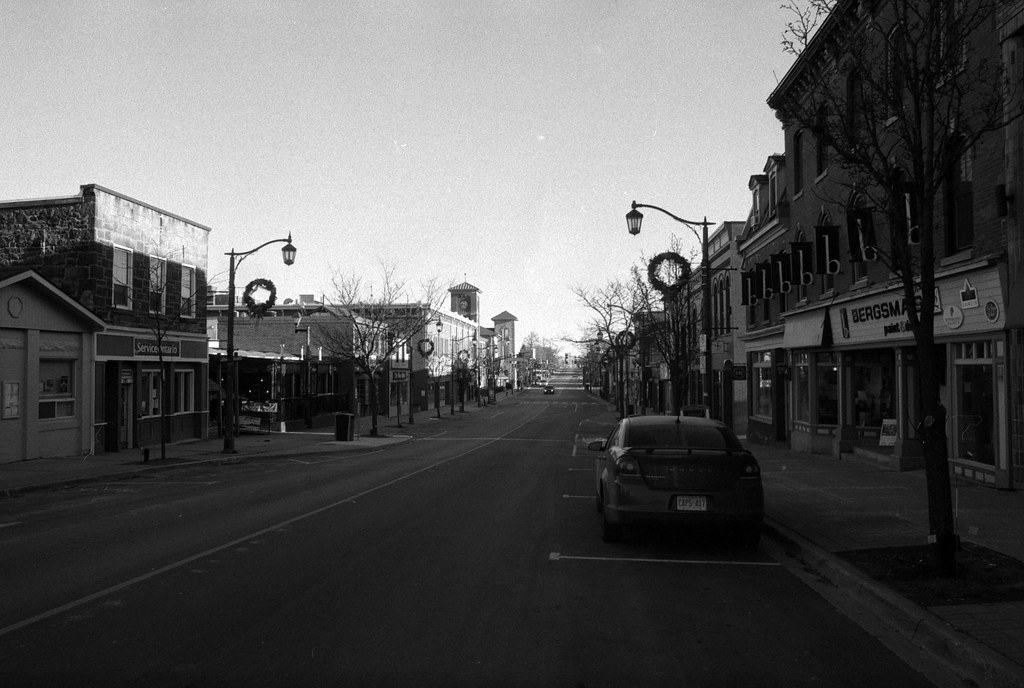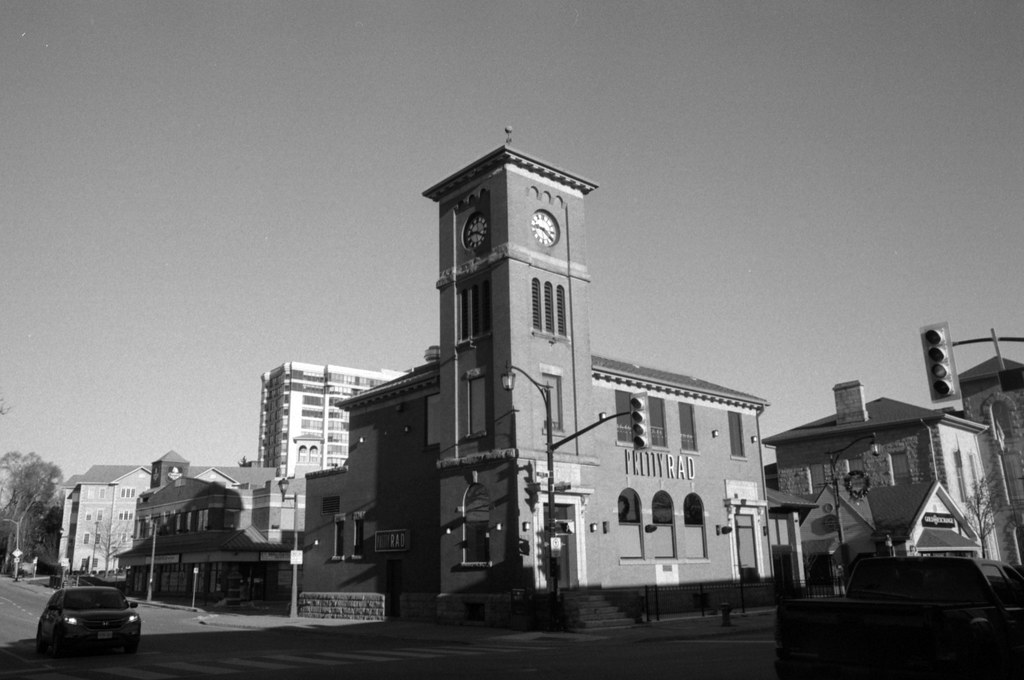If there is one place that I have photographed a lot in the past year it’s my hometown of Milton, heck I did a whole project on the town last year. Plus the current restrictions, Milton has become a space that I have gotten to know well. But the day I went out was also the first-ever virtual Toronto Film Shooters meetup. We were only able to meet once last year, and it looks like we’ll be doing the virtual thing for the near future. Rather than let this awesome group lapse in their gathering, we went virtual. I encouraged the group to head out in their own local areas, go solo and then met up later for the virtual pub through Zoom. You’ll see a blog post on Friday with the actual meet’s details because this post is about Milton.

Nikon FM – AI Nikkor 28mm 1:3.5 – Fompan 400 @ ASA-400 – Adox Atomal 49 (Stock) 10:00 @ 20C
The Neutral Nation members first occupied the earliest peoples who occupied the area that would become Milton, a loose collection of peoples who traded with both the Haudenosaunee (Iroquois) and Huron, sadly during the Beaver Wars, these Neutrals were all but killed by the 1650s. The area became the Iroquois territory, but they were also removed through the many wars that took place throughout the region, and the Mississaugas were the next to arrive. The rich forests, the escarpment and the sixteen-mile creek, made the area an excellent spot for a settlement. This attracted many Europeans, which starved out the Mississaugas who were forced into selling their land to the colonial government in 1818. The first two families to settle in the area designated Concession 2 of the Trafalgar Township were the Harrison family (Lot 12) and the Martins (Lot 14). The Harrisons established a farm, while the Martins built a grist mill and sawmill powered by the Sixteen Mile Creek. By the mid-1820s the area began to boom with the Fosters, Teetzels, Greens, Huffmans, and Whitefields joining the Martins and Huffmans. One note on the Harrisons, in 1824, Thomas died, leaving his wife Elizabeth to raise their children and tend to the farm. The small settlement remained a rural backwater, known as Martin’s Mills, as the Martins were the most influential families in the area. And while Jasper died in 1833, his son Edward continued to operate the family mills. The 1830s also brought further population growth, a local doctor and a school for the children. George Brown opened a general store and post office, giving the settlement the name Milton, after the English Poet who is rumoured to be Jasper’s favourite. The Teetzel family sold off much of their family plot in the 1840s that allowed for further expansion of the village’s settlement, more homes and churches began to arrive in the growing settlement. And the recognition as an official settlement in Gore District by 1843. When Halton county was separated from Wentworth in 1853, the rapid construction of County Offices and a Courthouse thanks to a donation by the Foster family saw Milton named the County Seat, much to Oakville’s annoyance. George Brown was elected the town’s first mayor in 1857 after official incorporation as a town. Through the next two decades, Milton’s growth was rapid, a stone town hall and market hall, library, newspaper, and further population growth. The railroad arrived in the 1870s with the Credit Valley Railroad being the first to arrive. The town’s economy continued to be driven by mills but was joined by brick and lime quarries. By the turn of the century, electricity and telephone works were added, along with several blacksmiths, a tannery, foundry, the Robertson Screw Company, telegraph, waterworks, and more. Milton’s growth remained fairly slow throughout the first half of the twentieth century. Still, with the arrival of personal automobiles and the move of many to the suburbs after the Second World War, Milton again saw growth well into the 1950s and 1960s. The stone mill build by Edward Martin burned down in 1963, replaced by a modern feed mill, known as the Super Sweet Mill, which lasted until 1991 when it was demolished. The last subdivisions were built in the 1980s with any further growth prevented due to the water supply. After the big pipe, that was resolved in 2001 allowed for even more growth the continue well into 2021. Today the population stands at well over 100,000.

Nikon FM – AI Nikkor 28mm 1:3.5 – Fompan 400 @ ASA-400 – Adox Atomal 49 (Stock) 10:00 @ 20C
Nikon FM – AI Nikkor 28mm 1:3.5 – Fompan 400 @ ASA-400 – Adox Atomal 49 (Stock) 10:00 @ 20C
Narrowing down a roll of twelve or fifteen to seven images is an easy task, but taking thirty-six, scanning down to around twenty or so keepers and then taking that down to seven is a hard task. But here at week four, I’m starting to get a hang for what I want to use the photos to share. While these were taken on a photo walk, I didn’t find that I should use these shots to tell the story of that walk because honestly, that’s not the theme of this post. Keeping that in my head made the choices easy. The top image is of the main street, while often quiet on a Saturday morning there is usually a bit more activity but because most of the coffee places and breakfast places are working on takeaway only, the traffic is light. The next two images are of two churches, the first being my home church of Knox the second being the original home of Knox, although greatly modified during its service as an armoury with much of the historic building now hidden under plaster and a squared-off entrance from 1931. I don’t even know if the original sanctuary remains intact. The inclusion of the former Credit Valley Railroad Station was an obvious choice, in fact, I planned out my walking route specifically to walk past the building as a call-back to Week 2. And I included the Waldie’s sign, not the whole shop to include a bit of detail, but since that blacksmith shop is fairly stand out both for my and the town’s history. The final two are other favourite buildings of mine in the downtown, the town hall, first built as a county courthouse and administration offices until 1981 when they became the local government’s seat. The second is the grand 1914 post office is one building I love capturing.

Nikon FM – AI-S Nikkor 50mm 1:1.4 – Fompan 400 @ ASA-400 – Adox Atomal 49 (Stock) 10:00 @ 20C
Nikon FM – AI Nikkor 135mm 1:2.8 – Fompan 400 @ ASA-400 – Adox Atomal 49 (Stock) 10:00 @ 20C
After developer Fomapan 400 in Adox Atomal 49 at a one-stop over-exposure and pulled in development and having a little more experience with how Atomal behaves I decided to shoot the film at full box speed (ASA-400) for this week. And the results were even better than last week when I developed in Acfine, which says a lot about Atomal. The reasons being that I was shooting in a lot of different locations under many different lighting conditions I wanted a bit more leeway when it comes to apertures and shutter speeds. The second reason is that with three different lenses, from a 28mm at the widest to 135mm at the longest I needed the capacity to have that fast shutter speed (1/250″ at least with my 135mm). And speaking of lenses, this week marked the first time I went out with a multiple lens kit, something that I never did with one of these projects in the past, often limiting myself to a single lens or even a single focal length. While that does help focus your work, having a little bit of flexibility also helps, especially when you’re working in an area you have worked a lot in the past year. I took along my 28mm, 50mm, and 135mm, three radically different focal lengths and made a point to note each exposure what lens I used to help track later when posting. While I mainly used the 28mm I was glad to have the 50 and 135, as I did use them in a couple of shots.

Nikon FM – AI Nikkor 28mm 1:3.5 – Fompan 400 @ ASA-400 – Adox Atomal 49 (Stock) 10:00 @ 20C
Nikon FM – AI Nikkor 28mm 1:3.5 – Fompan 400 @ ASA-400 – Adox Atomal 49 (Stock) 10:00 @ 20C
We’re staying in Milton next week as well, but heading out to one of many conservation parks for an early morning hike at the falls.
1 Comment